Congress and the public are rightly concerned about the future of Social Security. Many people have proposed novel and dramatic reforms to the system to assure its solvency or improve workers’ rate of return on their contributions. One popular proposal is to establish a new system of individual, privately managed retirement accounts that could be invested in high-return private securities, such as common stocks. This approach can push up workers’ returns – in the long run. But this can only occur if we increase the level of reserves that back up future pension promises. In other words, our retirement system must move away from pay-as-you-go financing and toward greater advance funding. This in turn requires that some Americans accept a temporary reduction in consumption, either by making larger contributions to the pension system or accepting smaller pensions.
Individual accounts have no inherent economic advantages over the alternative proposal to accumulate a larger reserve in the existing Social Security system. There are some political advantages to accumulating additional reserves in individual accounts, but there are efficiency advantages to accumulating reserves in a single collective account, such as the OASI Trust Fund. Accumulating private assets under either approach entails financial market risks. In one case the risks are borne collectively by the government (and ultimately by all taxpayers and pension recipients). Under a system of individual accounts, in contrast, the financial market risks would be borne by individual contributors and pensioners.
Since the basic goal of a government mandated pension system is to ensure workers a predictable and decent income in old age, the reform plan we ultimately adopt should be one in which the collective, defined-benefit plan provides the bulk of mandatory pensions, especially for workers with average and below-average lifetime wages. A single collective fund exposes these contributors to far less financial risk than an alternative system in which most of their retirement income is derived from individual investment accounts.
Risks and returns of individual accounts
Many critics of Social Security want to scale back the present defined-benefit plan and replace it partially or fully with a privately managed system of individual defined-contribution pension accounts. Such accounts could be run independently of traditional Social Security or as an additional element in the existing system. Advocates of individual accounts claim three big advantages from establishing individual accounts:
- It can lift the rate of return workers earn on their retirement contributions.
- It can boost national saving and future economic growth.
- It has practical political advantages in comparison with reforms in existing public programs that rely on higher payroll taxes or a bigger accumulation of public pension reserves.
Individual account plans differ from traditional Social Security in an important way. The worker’s ultimate retirement benefit depends solely on the size of the worker’s contributions and the success of the worker’s investment plan. Workers who make bigger contributions get bigger pensions; workers whose investments earn better returns receive larger pensions than workers who invest poorly.
The most commonly mentioned advantage of individual accounts is that they would permit workers to earn a much better rate of return than they are likely to achieve on their contributions to traditional Social Security. I have heard it claimed, for example, that workers will earn less than 0% real returns on their contributions to Social Security, while they could earn 8% to 10% on their contributions to an individual retirement account if it is invested in the U.S. stock market.
This comparison is incorrect and seriously misleading. First, the claimed return on Social Security contributions is too low. Some contributors will earn negative returns on their Social Security contributions, but on average future returns are expected to be between 1% and 1½%, even if taxes are increased and benefits reduced to restore long-term solvency.
Second, workers will not have an opportunity to earn the stock market rate of return on all of their retirement contributions, even if Congress establishes an individual account system in the near future. As noted above, workers’ overall rate of return on their contributions to the retirement system will be an average of the return obtained on their contributions to individual accounts and the return earned on their contributions to whatever remains of the traditional Social Security system. For most current workers, this overall rate of return will be much closer to the current return on Social Security contributions than it is to 8%.
Investment risk. Advocates of individual retirement accounts often overlook the investment risk inherent in these kinds of accounts. All financial market investments are subject to risk. Their returns, measured in constant, inflation-adjusted dollars, are not guaranteed. Over long periods of time, investments in the U.S. stock market have outperformed all other types of domestic U.S. financial investments, including Treasury bills, long-term Treasury bonds, and highly rated corporate bonds. But stock market returns are highly variable from one year to the next. In fact, they are substantially more variable over short periods of time than are the returns on safer assets, like U.S. Treasury bills. Chart 1 shows the pattern of real stock market returns over the period back through 1871. I have calculated the 15-year trailing real rate of return for periods ending in 1885, 1886, and all other years through 1998. The return is calculated by assuming that $1,000 is invested in the composite stock index defined by Standard and Poor’s and quarterly dividends are promptly reinvested in the composite stock. The 15-year trailing return has ranged between -2% and 13% since 1885. The historical real stock market return averaged about 6.3%.
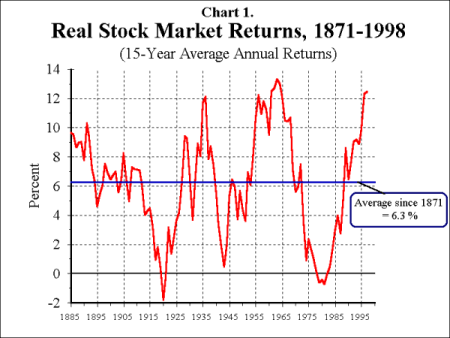
Some people mistakenly believe the annual ups and downs in stock market returns average out over time, assuring even the unluckiest investor of a high return if he or she invests steadily over a twenty-year period. A moment’s reflection shows that this cannot be true. From January 1973 to January 1975 the Standard and Poor’s composite stock market index fell 50% after adjusting for changes in the U.S. price level. The value of stock certificates purchased in 1972 and earlier years lost half their value in 24 months. For a worker who planned on retiring in 1975, the drop in stock market prices between 1973 and 1975 would have required a drastic reduction in consumption plans if the worker’s sole source of retirement income depended on stock market investments.
We can evaluate the financial market risks facing contributors to individual retirement accounts by considering the hypothetical pensions such workers would have obtained between 1910 and 1997. The 88 hypothetical contributors are assumed to have careers that last 40 years, beginning at age 22 and ending at age 62. When contributors reach age 62 they cease working and convert their accumulated retirement savings into a level annuity. To make the calculations comparable across time, all contributors are assumed to have an identical career path of earnings and to face the same mortality risks when they reach age 62. Contributors differ in the path of stock market returns, bond interest rates, and price inflation over their careers and retirement. These differences occur because of the differing start and end dates of the workers’ careers.
The results of this exercise can be summarized briefly. Even though workers on average obtain good pensions under individual retirement accounts, there is wide variability in outcomes. Assuming workers deposit 2% of their annual pay into a retirement account that is invested in common stocks, historical experience suggests their initial pensions can range from about 7% of their peak career earnings to 40% of their peak earnings. While most workers would welcome the opportunity to earn better returns on their contribution to the retirement system, defined-contribution accounts would expose workers to a substantial hazard that their pensions would be too small to finance a comfortable retirement. When we consider the effects of inflation on the value of annuities after workers retire, the financial market risks associated with individual accounts seem even bigger.
Details of the calculations. I have made calculations of the pensions that workers could expect under an individual account plan using information about annual stock market performance, interest rates, and inflation dating back to 1871.
I start with the assumption that workers enter the workforce at age 22 and work for 40 years until reaching their 62nd birthdays. I also assume they contribute 2% of their wages each year to their individual retirement accounts. Workers’ earnings typically rise throughout their careers until they reach their late 40s or early 50s, and then wages begin to fall. I assume that the age profile of earnings in a given year matches the age profile of earnings for American men in 1995 (as reported by the Census Bureau using tabulations from the March 1996 Current Population Survey). In addition, I assume that average earnings in the economy as a whole grow 1% a year.
While it would be interesting to see how workers’ pensions would vary if we altered the percentage of contributions invested in different assets, in my calculations I assume that all contributions are invested in stocks represented in the Standard and Poor’s composite stock index. Quarterly dividends from a worker’s stock holdings are immediately invested in stocks, too. Optimistically, I assume that workers incur no expenses buying, selling, trading, or holding stocks. (The average mutual fund that holds a broadly diversified stock portfolio annually charges shareholders a little more than 1% of assets under management. Even the most efficient funds impose charges equivalent to 0.2% of assets under management.) When workers reach their 62nd birthdays they use their stock accumulations to purchase a single-life annuity for males. (Joint survivor annuities for a worker and spouse would be about one-fifth lower.) To determine the annuity company’s charge for the annuity, I use the Social Security Actuary’s projected life table for males reaching age 65 in 1995. To earn a secure return on its investments, the annuity company is assumed to invest in long-term U.S. government bonds. The nominal interest rate on these bonds is shown in Chart 2. I assume that the annuity company sells a “fair” annuity: It does not earn a profit, incur administrative or selling costs, or impose extra charges to protect itself against the risk of adverse selection in its customer pool. (These assumptions are all unrealistic. Annuity companies typically charge an amount that is between 10% and 15% of the selling price of annuities to cover these items.) My assumptions therefore yield an overly optimistic estimate of the pension that each worker would receive.
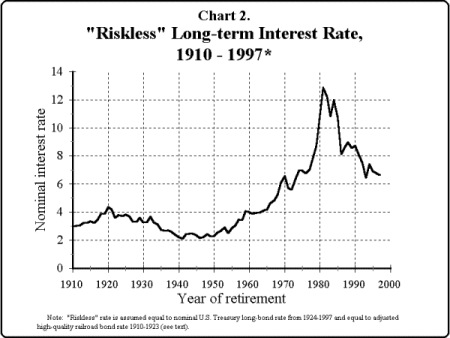
Chart 3 shows the replacement rate for workers retiring at the end of successive years from 1910 through 1997. The hypothetical experiences of 88 workers are reflected in this table. The worker who entered the workforce in 1871 and retired at the end of 1910, for example, would have accumulated enough savings in his individual retirement account to buy an annuity that replaced 19% of his peak lifetime earnings (that is, his average annual earnings between ages 54 and 58). The worker who entered the workforce in 1958 and retired at the end of 1997 could purchase an annuity that replaced 35% of his peak earnings. The highest replacement rate (40%) was obtained by the worker who entered the workforce in 1926 and retired at the end of 1965. The lowest (7%) was obtained by the worker who entered work in 1881 and retired in 1920. Nine-tenths of the replacement rates shown in the chart fall in the range between 10% and 37%. The average replacement rate was 20.7%. (For workers retiring after 1945 the replacement rate averaged 25.3%.)
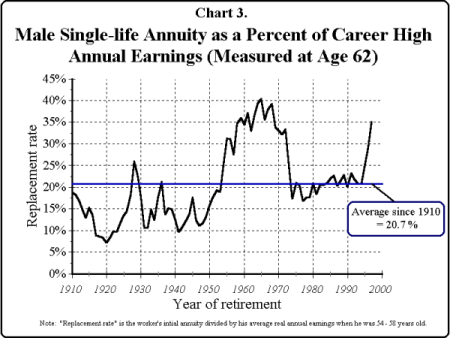
Chart 4 shows the real internal rate of return on the contributions made by the 88 workers. This return is measured at age 62, when the worker retires. Since 1910, when the first worker retired, the real internal rate of return ranged between 2% and almost 10%. The average rate of return was 6.4%.
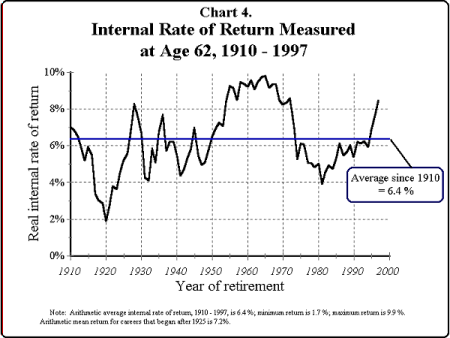
The principal lesson to be drawn from these calculations is that defined-contribution retirement accounts offer an uncertain basis for planning one’s retirement. Workers fortunate enough to retire when financial markets are strong obtain big pensions; workers with the misfortune to retire when markets are weak can be left with little to retire on. The biggest pension shown in Chart 3 is more than 5 times larger than the smallest one. Even in the period since the start of the Kennedy Administration, the experiences of retiring workers would have differed widely. The biggest pension was 2.4 times the size of the smallest one. In the six years from 1968 to 1974 the replacement rate fell 22 percentage points, plunging from 39% to 17%. In the three years from 1994 to 1997 it jumped 14 percentage points, rising from 21% to 35%. Social Security pensions have been far more predictable and have varied within a much narrower range. For that reason, traditional Social Security provides a much more solid basis for retirement planning and a much more reliable foundation for a publicly mandated basic pension.
The calculations in Charts 3 and 4 ignore the effects of inflation on the value of workers’ annuities after they retire. Workers typically cannot buy annuities that are indexed to the price level, as Social Security pensions are indexed. Chart 5 shows how the real replacement rate varied over workers’ retirements for four workers whose retirements began in 1920, 1928, 1932, and 1965. For workers who retired before World War II, prices did not always rise; in some periods, they fell. A worker receiving a level annuity receives a windfall when prices decline. The value of his annuity rises. But rising prices rather than falling prices have been the norm since the end of the Great Depression. A worker who began receiving a $100 monthly pension in 1965, for example, would have received a pension worth just $70 by the time he was 70 and just $31 by the time he was 80. The steep decline in the value of this worker’s pension is shown in Chart 5 with the line labeled “Year of retirement = 1965.”
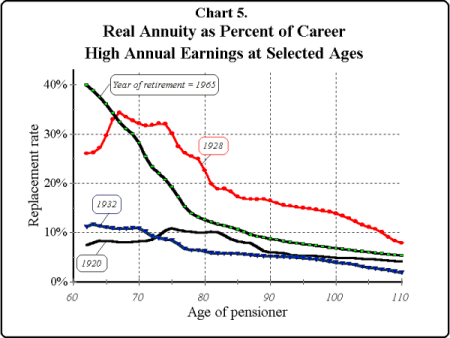
On average, inflation has reduced the rate of return workers would actually have obtained on their individual-account pensions. Chart 6 shows the trend in rates of return on worker contributions, when the rate of return is calculated at the age of death of workers rather than at age 62, when they first begin collecting pensions. Notice that the average realized rate of return is 1.2 percentage points lower than the rate of return calculated at age 62. This simply reflects the fact that, on average, workers would have received real annuities that are less in value than was anticipated when they first began their retirements.
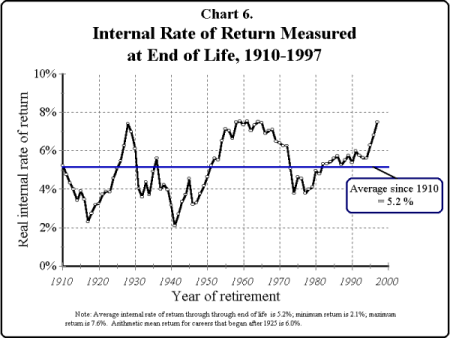
Conclusion
The debate about reforming Social Security should not rest on exaggerated claims about the potential gains workers can obtain from a shift to privately managed individual retirement accounts. Social Security provides workers with crucial protections against financial market risks. It is worth remembering that when the system was established in 1935, many industrial and trade union pension plans had collapsed as a result of the 1929 stock market crash and the Great Depression, leaving workers with no dependable source of income in old age. The private savings of many households was wiped out as well. Given these circumstances, most voters thought a public pension plan, backed by the taxing power of the federal government, was preferable to sole reliance on individual retirement plans.
Financial market fluctuations continue to make private retirement incomes uncertain. Workers who invest in financial market assets, such as common stocks, bonds, and annuities, are exposed to three kinds of risks: Tdhe risk that asset prices will decline around the time workers begin to retire; The risk that annuities will be expensive to buy when the worker must convert his retirement nest egg into a level annuity; And the risk that price inflation during the worker’s retirement will seriously erode the value of his annuity. The existence of these kinds of risk means that there is a continuing and crucial role for traditional Social Security, even in the case of workers who earn middle-class wages throughout their careers.


Commentary
TestimonyRisk and Returns of Stock Market Investments Held in Individual Retirement Accounts
May 11, 1999